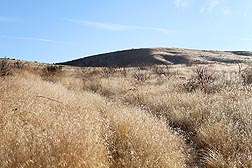New insights into invasive plant management

Over a decade of research at the U.S. Department of Agriculture (USDA) has resulted in the development of a new matrix for invasive plant management. The model was created by scientists with the Agricultural Research Service (ARS) in Burns, Ore., and helps land managers recognize how rangeland degradation processes vary across landscapes. ARS is USDA's chief scientific research agency.
Using the model can also increase the success rate of restoring native vegetation on damaged landscapes, which supports the USDA priority of responding to climate change.
Ecologist Roger Sheley synthesized a range of findings from scientific literature and field research to develop the model, which is called Ecologically Based Invasive-Plant Management (EBIPM). The process is a mix of plant establishment and succession theories, ecological principles, the identification of parameters that contribute to invasive plant management, and management actions that help restore native forage plants for livestock and wildlife. Sheley works at the ARS Range and Meadow Forage Management Research Unit in Burns.
Sheley and his colleagues based EBIPM on three general causes of plant succession: site availability, species availability, and species performance. They identified site-specific ecological processes that influence plant succession dynamics and determined how these processes are modified by environmental and human factors that affect plant establishment and long-term vegetation change. This information can be used to fine-tune the mechanisms and processes influencing plant succession, all of which helps rout invasive plants and support the return of native grasses and forbs.
Sheley and his colleagues tested their model in Montana's Kicking Horse Wildlife Mitigation Area at three sites that had varying degrees and types of damage from invasive plants. Using EBIPM, Sheley was able to increase the chance of restoration success by 66 percent over traditional approaches to invasive weed management. Sheley believes that EBIPM, which is also called "augmentative restoration," could be a valuable new tool for land managers in the western rangelands, where invasive plants like cheatgrass are fueling wildfires and limiting livestock grazing options.
Results from this work have been published in Rangeland Ecology and Management, Journal of Invasive Plant Science and Management, and www.ebipm.org .
More information: Read more about Sheley's research in the February 2012 issue of Agricultural Research magazine.
Provided by USDA Agricultural Research Service
















